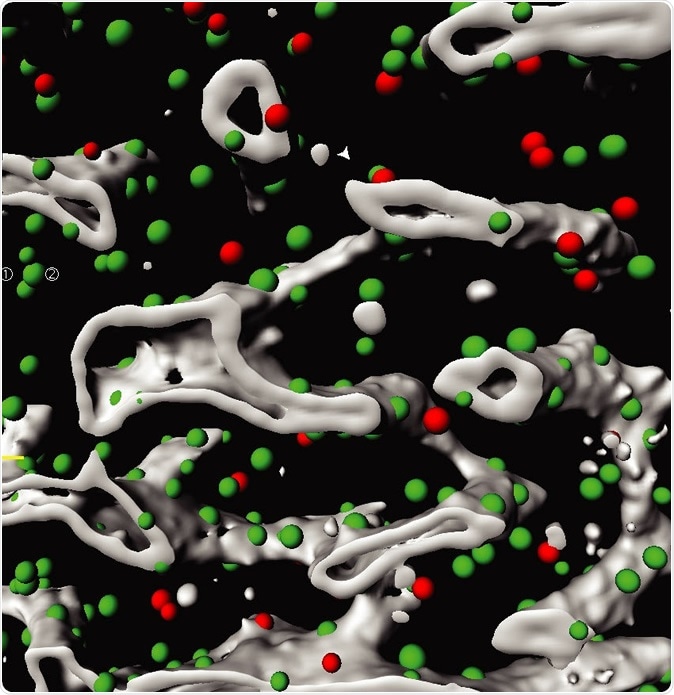The bone marrow, which is the spongy and viscous tissue that fills the bone, is the site of blood cell formation or hematopoiesis. If the bone marrow doesn’t work properly, it can lead to many blood diseases, including leukemia, sickle cell anemia, and lymphoma, among others.
In the bone marrow, stem cells regulate the production of blood and immune system cells. In the past, doctors study the stem cells through conventional methods. Now, a team of researchers from the European Molecular Biology Laboratory (EMBL), the Heidelberg Institute for Stem Cell Technology and Experimental Medicine (HI-STEM), and the German Cancer Research Center (DKFZ), developed a new way to study the three-dimensional make-up of the bone marrow at the single-cell level.
Bone marrow environment
With the new method, the researchers were able to identify previously unknown cell types that generate environments conducive for blood production from stem cells. The new study, which was published in Nature Cell Biology, sheds light on how complex the bone marrow is, including a new scientific basis to study blood diseases like leukemia.

Three dimensional segmentation of a bone marrow region. Different niche cells (green and red dots) and blood vessels (grey) are highlighted. Source: DKFZ, EMBL and University Hospital Zurich
In the study, the team focused on the murine bone marrow, which contains the stem cells pivotal for long-term blood cell production. For years, scientists have been interested in studying how to influence stem cells to sustain blood production. They believe that modifying the bone marrow environment can help in the formulation of new leukemia treatments and possible cure.
“So far, very little was known about how different cells are organized within the bone marrow and how they interact to maintain blood stem cells. Our approach unveils the cellular composition, the three-dimensional organization and the intercellular communication in the bone marrow, a tissue that has thus far been difficult to study using conventional methods," further explains Jude Al-Sabah, Ph.D. student in the Haas Group at HI-STEM and DKFZ,” Chiara Baccin, a post-doctorate in the Steinmetz Group at EMBL.
Using novel computational methods
To better understand bone marrow cells, the team used novel computational methods to determine how the cells are localized and how they affect stem cells by combining single-cell and spatial transcriptomics. They then studied the RNA content of bone marrow cells, identifying about 32 different cell types. These include those which are previously unknown and very rare, dubbed as rare niche cells.
The researchers believe that the rare cells are responsible for creating unique surroundings and environments in the bone marrow, which are required for the production of stem cells, new blood cells, and immune cells. They also determined the make-up of these cells in the bone marrow in three-dimensional and at the same time, project the cellular interactions and communication.
The dataset of the study can be accessed by laboratories across the globe to help in studying these cells and possibly, formulating novel therapies for blood diseases. In fact, the data is accessible by a web application.
With the help of the new computational method, scientists can now study the bone marrow and its internal environment. Future studies can make this as a basis for new findings, especially those which can pave the way for new treatments of life-threatening diseases of the blood, like leukemia.
How leukemias form
The blood has three types of cells – red blood cells that carry oxygen to the body parts, white blood cells that fight off infections, and platelets that help in blood clotting. The bone marrow is the site of blood cell production and every day, it makes billions of new blood cells.
Leukemia is a type of cancer that affects blood cells, both red blood cells and white blood cells. It develops when the DNA of developing blood cells suffers damage. As a result, the blood cells grow and divide uncontrollably. In leukemia, the body makes more white cells than it needs, but they aren’t working effectively. Since there are so many blood cells, somebody organs don’t work efficiently.
Over time, there will be no enough red blood cells for oxygen supply in the cells, there will be no enough platelets for clot the blood, and there will be not enough white blood cells to support the immune system.
Journal reference:
Baccin, C., Al-Sabah, J., Velten, L. et al. Combined single-cell and spatial transcriptomics reveal the molecular, cellular and spatial bone marrow niche organization. Nat Cell Biol (2019) doi:10.1038/s41556-019-0439-6, https://www.nature.com/articles/s41556-019-0439-6